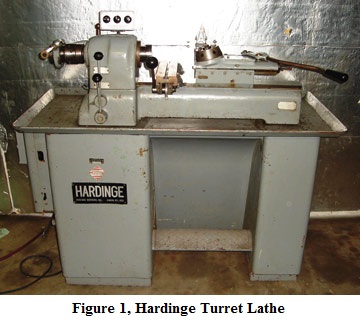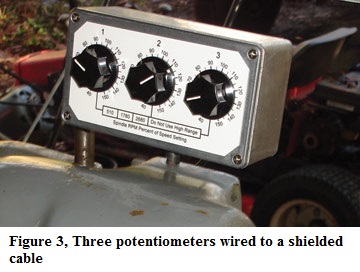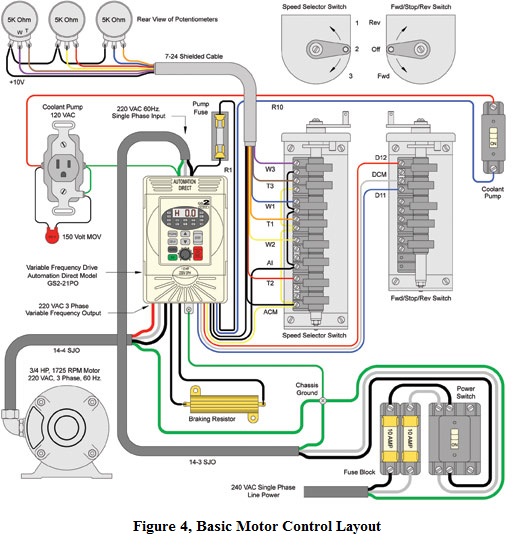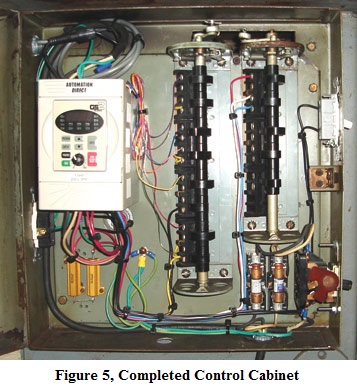Modernizing The Speed Controls Of Hardinge Turret Lathes Using AutomationDirect GS2 Variable Frequency Drives
Just about every machinist in the U.S. has encountered a Hardinge turret lathe during the course of their career. These little machines, commonly referred to as “second operation lathes”, are astoundingly productive pieces of equipment which still have great value in almost any machine shop. This holds true even in the face of the CNC tidal wave that seems to be overwhelming the machine industry. Used Hardinge turret lathes are inexpensive, readily available and use commonly available tooling. Once set up, a minimally trained operator can man the machine and generate production that will rival most CNC machines. These attributes allow these little lathes to produce substantial quantities of high precision parts at a very low cost per unit.
If the Hardinge turret lathe has a significant flaw, it would be the spindle speed control system. The spindle motor is generally a two-speed, 3-phase motor with 1750 and 825 RPM ranges. The motor speed and direction are easily changed during operation via a pair of levers mounted on the front of the spindle, which actuate large drum switches mounted in the control cabinet.
 The drive system comes in two different varieties, a fixed belt drive and a vary-drive. The fixed belt system uses a step pulley arrangement to change spindle speeds, which provides the operator with only two easily changeable speeds during operation. The vary-drive utilizes a pair of variable sheaves, which are controlled with a set of buttons adjacent to a speed indicator mounted on the top of the spindle. The vary-drive retains the two-speed motor and is a significant improvement over the fixed system. However, the vary-drive is slow to change and has a tendency to disrupt the flow of production. In addition, the two-speed motor selection will only allow the operator to halve the spindle speed at any given setting. If, as an example, the part being turned requires high speed operations, such as turning and/or drilling, a medium speed operation, such as reaming, and a low speed operation, such as threading, then the factory drive system begins to hinder production. Most machinists who have used these machines would agree that the speed control system is adequate, but a more flexible system would be a great improvement.
The drive system comes in two different varieties, a fixed belt drive and a vary-drive. The fixed belt system uses a step pulley arrangement to change spindle speeds, which provides the operator with only two easily changeable speeds during operation. The vary-drive utilizes a pair of variable sheaves, which are controlled with a set of buttons adjacent to a speed indicator mounted on the top of the spindle. The vary-drive retains the two-speed motor and is a significant improvement over the fixed system. However, the vary-drive is slow to change and has a tendency to disrupt the flow of production. In addition, the two-speed motor selection will only allow the operator to halve the spindle speed at any given setting. If, as an example, the part being turned requires high speed operations, such as turning and/or drilling, a medium speed operation, such as reaming, and a low speed operation, such as threading, then the factory drive system begins to hinder production. Most machinists who have used these machines would agree that the speed control system is adequate, but a more flexible system would be a great improvement.
After we purchased the Hardinge turret lathe shown in figure 1, it became obvious that something had to be done to improve the speed controls. I had had very good experiences with AutomationDirect GS2 variable frequency drives on several other pieces of equipment in our shop, so I decided to design a system for the turret lathe that would utilize one of these units. I configured a system that would retain the factory lever controls but expand on their basic function. Coupled with a variable frequency drive, this arrangement provides the operator quick access to a wide range of speed variations.
The original controls consisted of a fairly traditional motor controller with two heater blocks, a control transformer and a collection of lesser components, including a front-mounted panel switch rated at two horsepower. The forward and reverse functions are controlled with a pair of drum switches mounted on the back plane of the control cabinet. Even though they are overkill for logic switching, I retained the original drum switches because they are very high quality units and provided excellent tactile feedback to the operator.
 Figure 2 shows the schematic I designed for this particular project. If you take a minute to study the schematic, it becomes clear just how simple a wiring system can be when using a GS2 variable frequency drive. M1 is the spindle motor, M2 is the coolant pump, S1 is the original panel toggle switch, S3 is the speed control drum switch and S2 is the forward/off/reverse drum switch. I specified fuses for the main line and the coolant pump. The MOV is a metal oxide veristor intended to suppress inductive kick back when the coolant motor is turned off. R1 is a 200 ohm, 100 watt braking resistor intended to provide electrical braking action. This feature of the GS2 drive allowed me to completely remove the old mechanical brake that was originally supplied from the factory. P1 through P3 are 5K ohm potentiometers that provide quick adjustment to each of the three speeds selected by the lever on the front of the spindle. Since the potentiometers are mounted on the top of the spindle, a shielded cable is specified per the drive manual’s recommendation.
Figure 2 shows the schematic I designed for this particular project. If you take a minute to study the schematic, it becomes clear just how simple a wiring system can be when using a GS2 variable frequency drive. M1 is the spindle motor, M2 is the coolant pump, S1 is the original panel toggle switch, S3 is the speed control drum switch and S2 is the forward/off/reverse drum switch. I specified fuses for the main line and the coolant pump. The MOV is a metal oxide veristor intended to suppress inductive kick back when the coolant motor is turned off. R1 is a 200 ohm, 100 watt braking resistor intended to provide electrical braking action. This feature of the GS2 drive allowed me to completely remove the old mechanical brake that was originally supplied from the factory. P1 through P3 are 5K ohm potentiometers that provide quick adjustment to each of the three speeds selected by the lever on the front of the spindle. Since the potentiometers are mounted on the top of the spindle, a shielded cable is specified per the drive manual’s recommendation.
The second step I took was to configure the small cabinet shown in figure 3, which carries the three potentiometers wired to a shielded cable.
I also designed a simple pin bracket so it could be mounted into one of the existing equipment holes on the back of the spindle head. The label shown was made by printing the graphics on an ink jet printer and then laminating the page. The label was cut out and two-face carpet tape was used to bond it to the face of the cabinet. If you’re careful, this little trick can produce a clean, professional panel at almost no cost.
Next, I designed the control system to fit with the existing machine configuration. I typically make a general layout, as shown in figure 4, which guides the technician in the placement of the major components and routing of cables.
Figure 5 shows the control cabinet after completion, with the GS2 mounted at the upper left of the panel and the braking resistors placed just below. The original toggle switch (lower right) is now used as the primary power and connects to the double fuse block shown. A single-pole toggle switch was installed in the hole left by the original push button actuator (upper right). This switch overrides the coolant pump which plugs into the 120 VAC receptacle (lower left).
The GS2 drives are designed to suit nearly any motor application that one may encounter. As such, a little study was required to pick the parameters applicable to our specific project. However, once I familiarized myself with the unit, I found setting the parameters was a rather simple, step-by-step, process that you get accustomed to very quickly.
After double checking all of the completed wiring, I turned on the power to the GS2 drive and set up the basic parameters of the selected motor. Next, I programmed the source of frequency control to accept input from the potentiometers and set the acceleration and deceleration time to one second. There was a slight amount of over-spin (continued rotation) after the spindle was turned off, so I adjusted the DC injection current level, DC injection during stopping and the start-point for DC injection. This had the effect of stopping the spindle dead whenever the switch was turned off.
Overall material costs for the project were only $461.97. In anybody’s book, this is a small cost to bear, considering that this project reduced manufacturing time for two of our parts by 60% and three others by approximately 35%. This translated to the total material cost of the project being paid off in just one production run!
In conclusion, the modifications dramatically improved the functionality of our Hardinge turret lathe. With minimal costs, a productive machine was made even more productive. Overall, I would highly recommend this modification to any Hardinge turret lathe that is in regular service; it is well worth the effort.
By Brian S. Elliott
V.P. of Engineering and Manufacturing
Air Options, Inc.
Brian Elliott Bio
Brian Elliott is currently V.P. of Engineering and Manufacturing at Air Options, Inc. During the course of his long career, he has worked in various industrial, technical and scientific fields ranging from automated manufacturing to high energy physics. He has authored two books, “The Compressed Air Operations Manual” (ISBN 0-07-147526-5) and “Electromechanical Devices and Components” (ISBN-10 0-07-147752-7), both are published by the McGraw-Hill Book Company. Both books are available through book retailers worldwide.
Originally Published: June 1, 2008




